Cisco Systems 274, 474 User Manual

Cisco Wide Area Virtualization
Engine 274 and 474 Hardware
Installation Guide
November 2008
Americas Headquarters
Cisco Systems, Inc. 170 West Tasman Drive
San Jose, CA 95134-1706 USA http://www.cisco.com Tel: 408 526-4000
800 553-NETS (6387) Fax: 408 527-0883
Text Part Number: OL-17739-01
THE SPECIFICATIONS AND INFORMATION REGARDING THE PRODUCTS IN THIS MANUAL ARE SUBJECT TO CHANGE WITHOUT NOTICE. ALL STATEMENTS, INFORMATION, AND RECOMMENDATIONS IN THIS MANUAL ARE BELIEVED TO BE ACCURATE BUT ARE PRESENTED WITHOUT WARRANTY OF ANY KIND, EXPRESS OR IMPLIED. USERS MUST TAKE FULL RESPONSIBILITY FOR THEIR APPLICATION OF ANY PRODUCTS.
THE SOFTWARE LICENSE AND LIMITED WARRANTY FOR THE ACCOMPANYING PRODUCT ARE SET FORTH IN THE INFORMATION PACKET THAT SHIPPED WITH THE PRODUCT AND ARE INCORPORATED HEREIN BY THIS REFERENCE. IF YOU ARE UNABLE TO LOCATE THE SOFTWARE LICENSE OR LIMITED WARRANTY, CONTACT YOUR CISCO REPRESENTATIVE FOR A COPY.
The following information is for FCC compliance of Class A devices: This equipment has been tested and found to comply with the limits for a Class A digital device, pursuant to part 15 of the FCC rules. These limits are designed to provide reasonable protection against harmful interference when the equipment is operated in a commercial environment. This equipment generates, uses, and can radiate radio-frequency energy and, if not installed and used in accordance with the instruction manual, may cause harmful interference to radio communications. Operation of this equipment in a residential area is likely to cause harmful interference, in which case users will be required to correct the interference at their own expense.
The following information is for FCC compliance of Class B devices: The equipment described in this manual generates and may radiate radio-frequency energy. If it is not installed in accordance with Cisco’s installation instructions, it may cause interference with radio and television reception. This equipment has been tested and found to comply with the limits for a Class B digital device in accordance with the specifications in part 15 of the FCC rules. These specifications are designed to provide reasonable protection against such interference in a residential installation. However, there is no guarantee that interference will not occur in a particular installation.
Modifying the equipment without Cisco’s written authorization may result in the equipment no longer complying with FCC requirements for Class A or Class B digital devices. In that event, your right to use the equipment may be limited by FCC regulations, and you may be required to correct any interference to radio or television communications at your own expense.
You can determine whether your equipment is causing interference by turning it off. If the interference stops, it was probably caused by the Cisco equipment or one of its peripheral devices. If the equipment causes interference to radio or television reception, try to correct the interference by using one or more of the following measures:
•Turn the television or radio antenna until the interference stops.
•Move the equipment to one side or the other of the television or radio.
•Move the equipment farther away from the television or radio.
•Plug the equipment into an outlet that is on a different circuit from the television or radio. (That is, make certain the equipment and the television or radio are on circuits controlled by different circuit breakers or fuses.)
Modifications to this product not authorized by Cisco Systems, Inc. could void the FCC approval and negate your authority to operate the product.
The Cisco implementation of TCP header compression is an adaptation of a program developed by the University of California, Berkeley (UCB) as part of UCB’s public domain version of the UNIX operating system. All rights reserved. Copyright © 1981, Regents of the University of California.
NOTWITHSTANDING ANY OTHER WARRANTY HEREIN, ALL DOCUMENT FILES AND SOFTWARE OF THESE SUPPLIERS ARE PROVIDED “AS IS” WITH ALL FAULTS. CISCO AND THE ABOVE-NAMED SUPPLIERS DISCLAIM ALL WARRANTIES, EXPRESSED OR IMPLIED, INCLUDING, WITHOUT LIMITATION, THOSE OF MERCHANTABILITY, FITNESS FOR A PARTICULAR PURPOSE AND NONINFRINGEMENT OR ARISING FROM A COURSE OF DEALING, USAGE, OR TRADE PRACTICE.
IN NO EVENT SHALL CISCO OR ITS SUPPLIERS BE LIABLE FOR ANY INDIRECT, SPECIAL, CONSEQUENTIAL, OR INCIDENTAL DAMAGES, INCLUDING, WITHOUT LIMITATION, LOST PROFITS OR LOSS OR DAMAGE TO DATA ARISING OUT OF THE USE OR INABILITY TO USE THIS MANUAL, EVEN IF CISCO OR ITS SUPPLIERS HAVE BEEN ADVISED OF THE POSSIBILITY OF SUCH DAMAGES.
CCDE, CCENT, Cisco Eos, Cisco Lumin, Cisco Nexus, Cisco StadiumVision, Cisco TelePresence, Cisco WebEx, the Cisco logo, DCE, and Welcome to the Human Network are trademarks; Changing the Way We Work, Live, Play, and Learn and Cisco Store are service marks; and Access Registrar, Aironet, AsyncOS, Bringing the Meeting To You, Catalyst, CCDA, CCDP, CCIE, CCIP, CCNA, CCNP, CCSP, CCVP, Cisco, the
Cisco Certified Internetwork Expert logo, Cisco IOS, Cisco Press, Cisco Systems, Cisco Systems Capital, the Cisco Systems logo, Cisco Unity, Collaboration Without Limitation, EtherFast, EtherSwitch, Event Center, Fast Step, Follow Me Browsing, FormShare, GigaDrive, HomeLink, Internet Quotient, IOS, iPhone, iQuick Study, IronPort, the IronPort logo, LightStream, Linksys, MediaTone, MeetingPlace, MeetingPlace Chime Sound, MGX, Networkers, Networking Academy, Network Registrar, PCNow, PIX, PowerPanels, ProConnect, ScriptShare, SenderBase, SMARTnet, Spectrum Expert, StackWise, The Fastest Way to Increase Your Internet Quotient, TransPath, WebEx, and the WebEx logo are registered trademarks of Cisco Systems, Inc. and/or its affiliates in the United States and certain other countries.
All other trademarks mentioned in this document or website are the property of their respective owners. The use of the word partner does not imply a partnership relationship between Cisco and any other company. (0809R)
Any Internet Protocol (IP) addresses used in this document are not intended to be actual addresses. Any examples, command display output, and figures included in the document are shown for illustrative purposes only. Any use of actual IP addresses in illustrative content is unintentional and coincidental.
This document may reproduce requested material from HP. Copyright 2007 Hewlett-Packard Development Company, L.P. Reproduced with Permission.
Cisco Wide Area Virtualization Engine 274 and 474 Hardware Installation Guide
© 2008 Cisco Systems, Inc. All rights reserved.

C O N T E N T S
|
|
Preface ix |
|
|
|
|
Introducing the Cisco Wide Area Virtualization Engine |
|
|
C H A P T E R |
1 |
1-1 |
||
|
|
Supported Products |
1-1 |
|
|
|
Hardware Features |
1-2 |
|
|
|
Front Panel Controls and LEDs 1-2 |
|
|
|
|
Location of Ports and Connectors 1-3 |
|
|
|
|
Preparing to Install the Wide Area Virtualization Engine |
|
|
C H A P T E R |
2 |
2-1 |
||
|
|
Safety Warnings 2-1 |
|
|
|
|
Safety Guidelines |
2-4 |
|
|
General Precautions |
2-4 |
|
|
System Reliability Considerations 2-6 |
|
|
|
Protecting Against Electrostatic Discharge |
2-7 |
|
|
Installing the Wide Area Virtualization Engine |
|
|
C H A P T E R 3 |
3-1 |
||
|
Installing the WAVE Appliance on a Tabletop |
3-2 |
|
|
Installing the WAVE Appliance on a Wall 3-2 |
|
|
|
Installing the WAVE Appliance in an Equipment Rack 3-5 |
||
|
Rack-Mounting Considerations 3-5 |
|
|
|
Rack Requirements |
3-6 |
|
|
Connecting Cables 3-6 |
|
|
|
|
Connecting Power and Booting the System |
3-6 |
|
|
|
Cisco Wide Area Virtualization Engine 274 and 474 Hardware Installation Guide |
|
|
|
|
||||
|
OL-17739-01 |
|
|
v |
|
|
|
||

Contents
Checking the LEDs 3-7
Removing or Replacing a WAVE Appliance 3-7
C H A P T E R |
4 |
WAVE Inline Network Adapter 4-1 |
|
|
|
|
Inline Network Adapter Description 4-1 |
|
|
|
|
Ports and LED Indicators |
4-3 |
|
|
|
Inline Network Adapter Cabling Requirements |
4-4 |
|
|
|
Installation Scenarios and Cabling Examples for Fast Ethernet Connections 4-7 |
||
|
|
Troubleshooting the System Hardware 5-1 |
|
|
C H A P T E R |
5 |
|
||
|
|
Identifying System Problems 5-2 |
|
|
|
|
Checking Connections and Switches 5-3 |
|
|
|
|
Troubleshooting the Ethernet Controller 5-4 |
|
|
|
|
Network Connection Problems 5-4 |
|
|
|
|
Ethernet Controller Troubleshooting Chart |
5-5 |
|
|
|
Undetermined Problems |
5-6 |
|
|
|
Problem-Solving Tips 5-7 |
|
|
|
|
Symptoms and Solutions |
5-8 |
|
|
|
Power-On Self Test (POST) 5-12 |
|
|
|
|
POST Overview 5-12 |
|
|
|
|
POST Numeric Codes and Text Messages |
5-13 |
|
|
|
Interpreting POST Diagnostic Front Panel LEDs and Beep Codes 5-16 |
||
|
|
Wide Area Virtualization Engine Hardware Specifications A-1 |
||
A P P E N D I X |
A |
|||
|
|
Appliance Specifications |
A-1 |
|
Inline Adapter Specifications A-4
Cisco Wide Area Virtualization Engine 274 and 474 Hardware Installation Guide
vi |
OL-17739-01 |
|
|

Contents
A P P E N D I X B |
Maintaining the Wide Area Virtualization Engine B-1 |
||||
|
Maintaining Your Site Environment |
B-1 |
|||
|
Temperature B-2 |
|
|
|
|
|
Humidity |
B-3 |
|
|
|
|
Altitude |
B-3 |
|
|
|
|
Dust and Particles |
B-4 |
|
|
|
|
Corrosion |
B-4 |
|
|
|
|
Electrostatic Discharge B-4 |
|
|
||
|
Electromagnetic and Radio Frequency Interference B-5 |
||||
|
Magnetism B-5 |
|
|
|
|
|
Shock and Vibration B-6 |
|
|
||
|
Power Source Interruptions |
B-6 |
|
||
|
Using Power Protection Devices |
B-7 |
|
||
|
Surge Protectors |
B-7 |
|
|
|
|
Line Conditioners |
B-8 |
|
|
|
|
Uninterruptible Power Supplies |
B-8 |
|||
I N D E X
|
|
Cisco Wide Area Virtualization Engine 274 and 474 Hardware Installation Guide |
|
|
|
|
|
||
|
OL-17739-01 |
|
|
vii |
|
|
|

Contents
|
Cisco Wide Area Virtualization Engine 274 and 474 Hardware Installation Guide |
viii |
OL-17739-01 |

Preface
This preface describes the purpose of the Cisco Wide Area Virtualization Engine 274 and 474 Hardware Installation Guide, who should read it, how it is organized, and its document conventions.
This preface contains the following sections:
•Purpose, page ix
•Audience, page x
•Organization, page x
•Conventions, page xi
•Related Documentation, page xviii
•Obtaining Documentation, Obtaining Support, and Security Guidelines, page xix
Purpose
This installation guide explains how to prepare your site for installation, how to install a Wide Area Virtualization Engine (WAVE) appliance, and how to maintain and troubleshoot the system hardware. After completing the hardware installation procedures covered in this guide, you will then use the appropriate related publications to configure your system. (See the “Related Documentation” section on page xviii.)
Cisco Wide Area Virtualization Engine 274 and 474 Hardware Installation Guide
|
OL-17739-01 |
ix |
|

Preface
Audience
To use this installation guide, you should be familiar with internetworking equipment and cabling, and have a basic knowledge of electronic circuitry and wiring practices.
To complete the installation, including the software configuration for your WAVE appliance and for the router that works with the WAVE appliance, you should be familiar with basic networking principles, router configuration, and web page protocols.
Warning Only trained and qualified personnel should be allowed to install, replace, or service this equipment. Statement 1030
Organization
This guide includes the following chapters:
Chapter |
Title |
Description |
|
|
|
Chapter 1 |
Introducing the Cisco Wide |
Describes the physical properties |
|
Area Virtualization Engine |
and provides a functional overview |
|
|
of the Cisco Wide Area |
|
|
Virtualization Engine 274 and 474. |
|
|
|
Chapter 2 |
Preparing to Install the Wide |
Describes safety considerations |
|
Area Virtualization Engine |
and gives an overview of the |
|
|
installation and procedures that |
|
|
you should perform before the |
|
|
actual installation. |
|
|
|
Chapter 3 |
Installing the Wide Area |
Describes how to install the |
|
Virtualization Engine |
hardware and connect the external |
|
|
network interface cables. |
|
|
|
Chapter 4 |
WAVE Inline Network |
Describes the Cisco WAVE inline |
|
Adapter |
network adapter and how to use it. |
|
|
|
Cisco Wide Area Virtualization Engine 274 and 474 Hardware Installation Guide
x |
OL-17739-01 |
|
|

Preface
|
|
|
|
|
|
|
|
Chapter |
Title |
Description |
|
|
|
|
|
Chapter 5 |
Troubleshooting the System |
Describes troubleshooting |
|
|
Hardware |
procedures for the hardware |
|
|
|
installation. |
|
|
|
|
|
Appendix A |
Wide Area Virtualization |
Gives a summary of the hardware |
|
|
Engine Hardware |
features and specifications. |
|
|
Specifications |
|
|
|
|
|
|
Appendix B |
Maintaining the Wide Area |
Describes how to maintain the |
|
|
Virtualization Engine |
Wide Area Virtualization Engine. |
|
|
|
|
|
Conventions
Command descriptions use the following conventions:
Convention |
Description |
|
|
boldface font |
Commands and keywords are in boldface. |
|
|
italic font |
Variables for which you supply values are in italics. |
|
|
[ ] |
Elements in square brackets are optional. |
|
|
{x | y | z} |
Alternative keywords are grouped in braces and separated |
|
by vertical bars. |
|
|
[x | y | z] |
Optional alternative keywords are grouped in brackets and |
|
separated by vertical bars. |
|
|
string |
A nonquoted set of characters. Do not use quotation marks |
|
around the string, or the string will include the |
|
quotation marks. |
|
|
Cisco Wide Area Virtualization Engine 274 and 474 Hardware Installation Guide
|
OL-17739-01 |
xi |
|
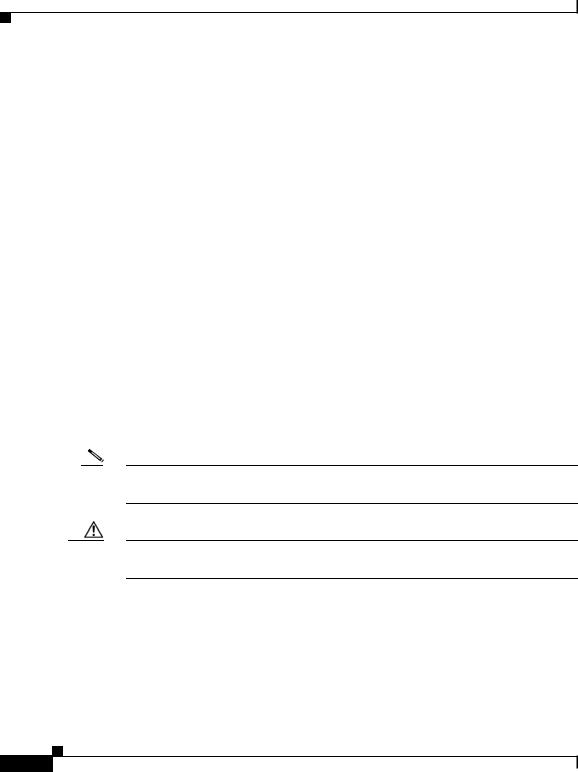
Preface
Screen examples use the following conventions:
Convention |
Description |
|
|
|
|
screen font |
Terminal sessions and information the system displays are |
|
|
|
in screen font. |
|
|
|
boldface screen |
Information you must enter is in boldface screen font. |
|
font |
|
|
|
|
|
italic screen |
Variables for which you supply values are in italic screen |
|
font |
font. |
|
|
|
|
^ |
|
The symbol ^ represents the key labeled Control—for |
|
|
example, the key combination ^D in a screen display means |
|
|
hold down the Control key while you press the D key. |
|
|
|
< |
> |
Nonprinting characters, such as passwords, are in angle |
|
|
brackets. |
|
|
|
[ |
] |
Default responses to system prompts are in square brackets. |
|
|
|
!, # |
An exclamation point (!) or a pound sign (#) at the |
|
|
|
beginning of a line of code indicates a comment line. |
|
|
|
Notes, cautionary statements, and safety warnings use these conventions:
Note Means reader take note. Notes contain helpful suggestions or references to materials not contained in this manual.
Caution Means reader be careful. You are capable of doing something that might result in equipment damage or loss of data.
|
Cisco Wide Area Virtualization Engine 274 and 474 Hardware Installation Guide |
xii |
OL-17739-01 |
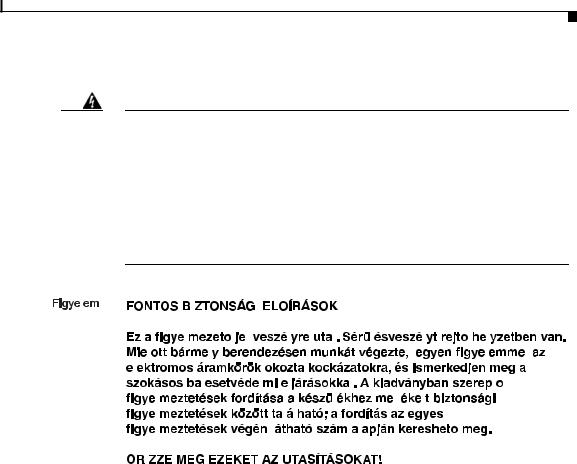
Preface
Warning IMPORTANT SAFETY INSTRUCTIONS
This warning symbol means danger. You are in a situation that could cause bodily injury. Before you work on any equipment, be aware of the hazards involved with electrical circuitry and be familiar with standard practices for preventing accidents. Use the statement number provided at the end of each warning to locate its translation in the translated safety warnings that accompanied this device. Statement 1071
SAVE THESE INSTRUCTIONS
|
|
|
|
|
|
|
|
|
|
|
|
|
|
|
|
|
|
|
|
|
|
|
|
|
|
|
|
|
|
|
|
|
|
|
|
|
|
|
|
|
|
|
|
|
|
|
|
|
|
|
|
|
|
|
|
|
|
|
|
|
|
|
|
|
|
|
|
|
|
|
|
|
|
|
|
|
|
|
|
|
|
|
|
|
|
|
|
|
|
|
|
|
|
|
|
|
|
|
|
|
|
|
|
|
|
|
|
|
|
|
|
|
|
|
|
|
|
|
|
|
|
|
|
|
|
|
|
|
|
|
|
|
|
|
|
|
|
|
|
|
|
|
|
|
|
|
|
|
|
|
|
|
|
|
|
|
|
|
|
|
|
|
|
|
|
|
|
|
|
|
|
|
|
|
|
|
|
|
|
|
|
|
|
|
|
|
|
|
|
|
|
|
|
|
|
|
|
|
|
|
|
|
|
|
|
|
|
|
|
|
|
|
|
|
|
|
|
|
|
|
|
|
|
|
|
|
|
|
|
|
|
|
|
|
|
|
|
|
|
|
|
|
|
|
|
|
|
|
|
|
|
|
|
|
|
|
|
|
|
|
|
|
|
|
|
|
|
|
|
|
|
|
|
|
|
|
|
|
|
|
|
|
|
|
|
|
|
|
|
|
|
|
|
|
|
|
|
|
|
|
|
|
|
|
|
|
|
|
|
|
|
|
|
|
|
|
|
|
|
|
|
|
|
|
|
|
|
|
|
|
|
|
|
|
|
|
|
|
|
|
|
|
|
|
|
|
|
|
|
|
|
|
|
|
|
|
|
|
|
|
|
|
|
|
|
|
|
|
|
|
|
|
|
|
|
|
|
|
|
|
|
|
|
|
|
|
|
|
|
|
|
|
|
|
|
|
|
|
|
|
|
|
|
|
|
|
|
|
|
|
|
|
|
|
|
|
|
|
|
|
|
|
|
|
|
|
|
|
|
|
|
|
|
|
|
|
|
|
|
|
|
|
|
|
|
|
|
|
|
|
|
|
|
|
|
|
|
|
|
|
|
|
|
|
|
|
|
|
Cisco Wide Area Virtualization Engine 274 and 474 Hardware Installation Guide |
|
|
|||||||||||||||||||||
|
|
|
|
|
|
|
||||||||||||||||||||||
|
|
|
|
|
|
|
||||||||||||||||||||||
|
|
|
|
|
||||||||||||||||||||||||
|
OL-17739-01 |
|
|
|
|
|
|
|
|
|
|
|
|
|
|
|
|
|
|
|
|
|
|
|
|
xiii |
||
|
|
|
|
|
|
|
|
|
|
|
|
|
|
|
|
|
|
|
|
|
|
|
|
|
||||
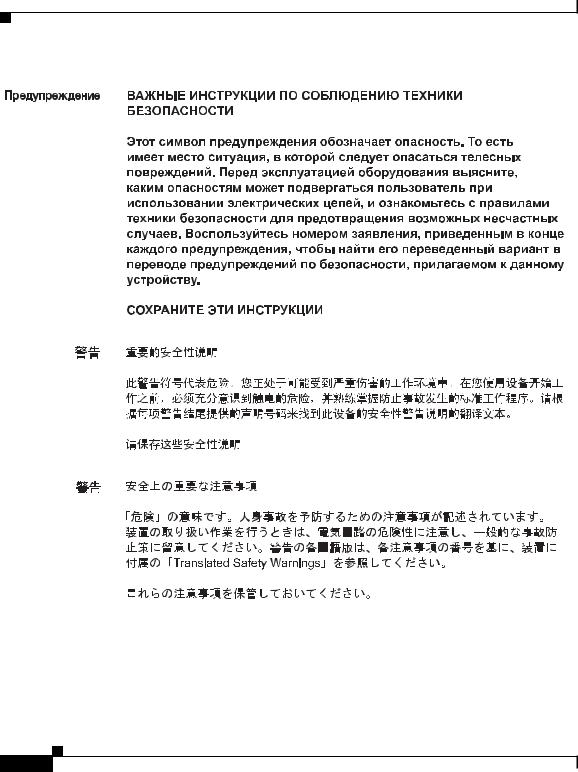
Preface
|
Cisco Wide Area Virtualization Engine 274 and 474 Hardware Installation Guide |
xiv |
OL-17739-01 |
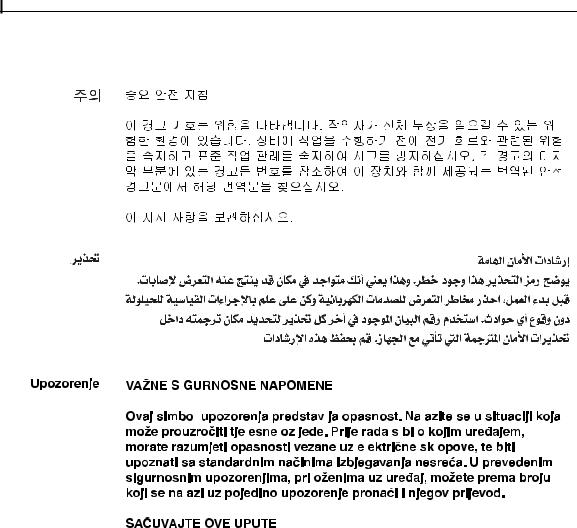
Preface
|
|
|
|
|
|
|
|
|
|
|
|
|
|
|
|
|
|
|
|
|
|
|
|
|
|
|
|
|
|
|
|
|
|
|
|
|
|
|
|
|
|
|
|
|
|
|
|
|
|
|
|
|
|
|
|
|
|
|
|
|
|
|
|
|
|
|
|
|
|
|
|
|
|
|
|
|
|
|
|
|
|
|
|
|
|
|
|
|
|
|
|
|
|
|
|
|
|
|
|
|
|
|
|
|
|
|
|
|
|
|
|
|
|
|
|
|
|
|
|
|
|
|
|
|
|
|
|
|
|
|
|
|
|
|
|
|
|
|
|
|
|
|
|
|
|
|
|
|
|
|
|
|
|
|
|
|
|
|
|
|
|
|
|
|
|
|
|
|
|
|
|
|
|
|
|
|
|
|
|
|
|
|
|
|
|
|
|
|
|
|
|
|
|
|
|
|
|
|
|
|
|
|
|
|
|
|
|
|
|
|
|
|
|
|
|
|
|
|
|
|
|
|
Cisco Wide Area Virtualization Engine 274 and 474 Hardware Installation Guide |
|
|
|
|||||||||||
|
|
|
||||||||||||||
|
OL-17739-01 |
|
|
|
|
|
|
|
|
|
|
|
|
|
xv |
|
|
|
|
|
|
|
|
|
|
|
|
|
|
|
|||
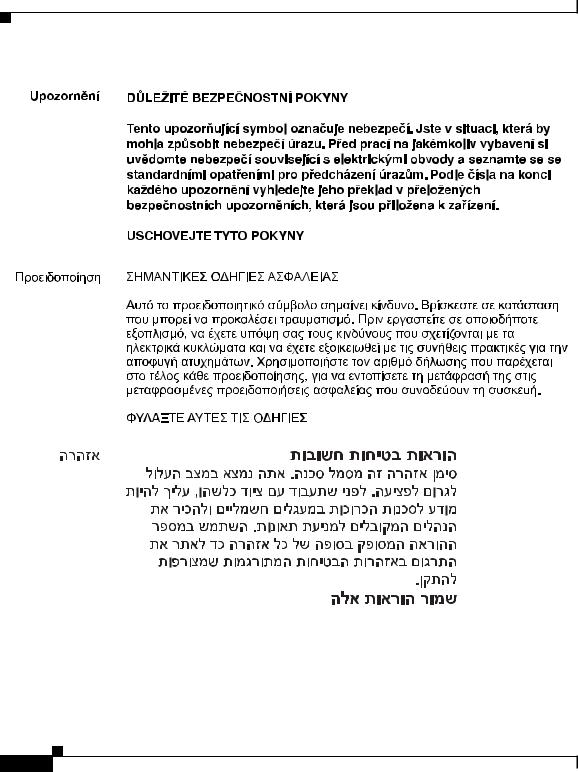
Preface
|
Cisco Wide Area Virtualization Engine 274 and 474 Hardware Installation Guide |
xvi |
OL-17739-01 |
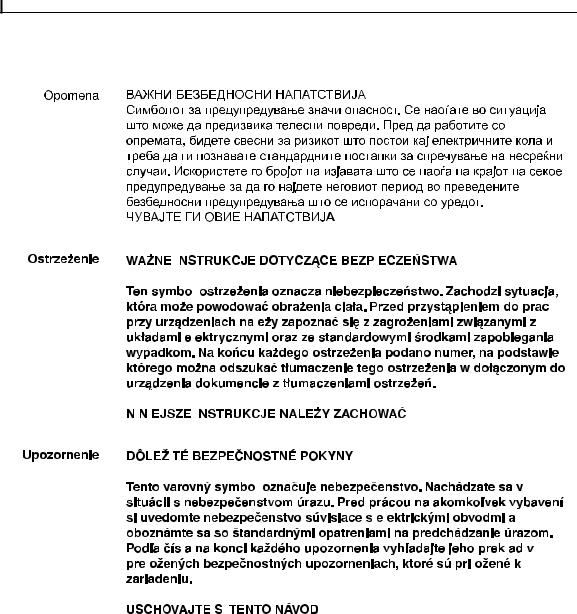
Preface
|
|
|
|
|
|
|
|
|
|
|
|
|
|
|
|
|
|
|
|
|
|
|
|
|
|
|
|
|
|
|
|
|
|
|
|
|
|
|
|
|
|
|
|
|
|
|
|
|
|
|
|
|
|
|
|
|
|
|
|
|
|
|
|
|
|
|
|
|
|
|
|
|
|
|
|
|
|
|
|
|
|
|
|
|
|
|
|
|
|
|
|
|
|
|
|
|
|
|
|
|
|
|
|
|
|
|
|
|
|
|
|
|
|
|
|
|
|
|
|
|
|
|
|
|
|
|
|
|
|
|
|
|
|
|
|
|
|
|
|
|
|
|
|
|
|
|
|
|
|
|
|
|
|
|
|
|
|
|
|
|
|
|
|
|
|
|
|
|
|
|
|
|
|
|
|
|
|
|
|
|
|
|
|
|
|
|
|
|
|
|
|
|
|
|
|
|
|
|
|
|
|
|
|
|
|
|
|
|
|
|
|
|
|
|
|
|
|
|
|
|
|
|
|
|
|
|
|
|
|
|
|
|
|
|
|
|
|
|
|
|
|
|
|
|
|
|
|
|
|
|
|
|
|
|
|
|
|
|
|
|
|
|
|
|
|
|
|
|
|
|
|
|
|
|
|
|
|
|
|
|
|
|
|
|
|
|
|
|
|
|
|
|
|
|
|
|
|
|
|
|
|
|
|
|
|
|
|
|
|
|
|
|
|
|
|
|
|
|
|
|
|
|
|
|
|
|
|
|
|
|
|
|
|
|
|
|
|
|
|
|
|
|
|
|
|
|
|
|
|
|
|
|
|
|
|
|
|
|
|
|
|
|
|
|
|
|
|
|
|
|
|
|
|
|
|
|
|
|
|
|
|
|
|
|
|
|
|
|
|
|
|
|
|
Cisco Wide Area Virtualization Engine 274 and 474 Hardware Installation Guide |
|
|
|
||||||||||
|
|
|
||||||||||||||
|
OL-17739-01 |
|
|
|
|
|
|
|
|
|
|
|
|
|
xvii |
|
|
|
|
|
|
|
|
|
|
|
|
|
|
|
|||
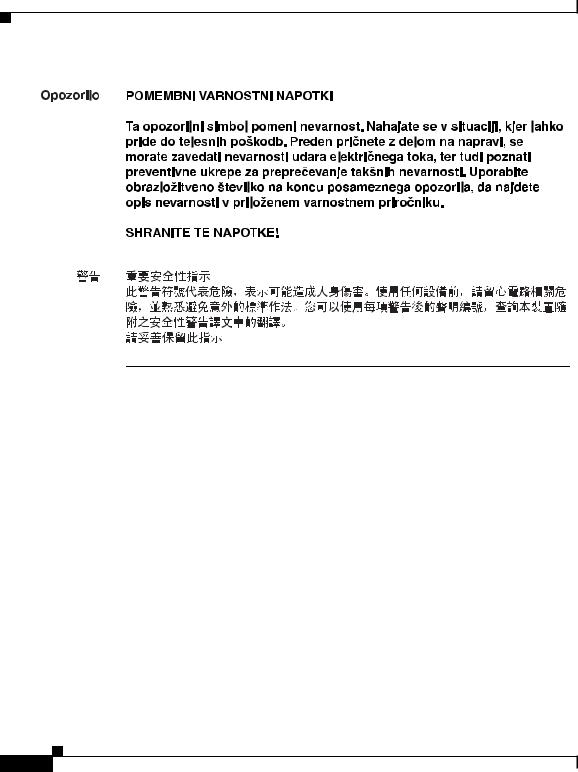
Preface
Related Documentation
The WAVE appliance supports the Cisco Wide Area Application Services software (WAAS). The WAVE appliance can function as either a WAAS Central Manager or as an Application Acceleration Engine.
The Cisco WAAS software document set includes the following documents:
•Release Note for Cisco Wide Area Application Services
•Cisco Wide Area Application Services Command Reference
•Cisco Wide Area Application Services Quick Configuration Guide
•Cisco Wide Area Application Services Configuration Guide
•Cisco Wide Area Application Services API Reference
•Cisco WAAS Installation and Configuration Guide for Windows on a Virtual Blade
The documentation for this product also includes the following hardware-related documents:
|
Cisco Wide Area Virtualization Engine 274 and 474 Hardware Installation Guide |
xviii |
OL-17739-01 |

Preface
•Regulatory Compliance and Safety Information for the Cisco Wide Area Virtualization Engines
Obtaining Documentation, Obtaining Support, and
Security Guidelines
For information on obtaining documentation, obtaining support, providing documentation feedback, security guidelines, and also recommended aliases and general Cisco documents, see the monthly What’s New in Cisco Product Documentation, which also lists all new and revised Cisco technical documentation, at:
http://www.cisco.com/en/US/docs/general/whatsnew/whatsnew.html
|
|
Cisco Wide Area Virtualization Engine 274 and 474 Hardware Installation Guide |
|
|
|
|
|
||
|
OL-17739-01 |
|
|
xix |
|
|
|

Preface
|
Cisco Wide Area Virtualization Engine 274 and 474 Hardware Installation Guide |
xx |
OL-17739-01 |

C H A P T E R 1
Introducing the Cisco Wide Area
Virtualization Engine
This chapter provides a basic functional overview of the Cisco Wide Area Virtualization Engine (WAVE) 274 and 474 appliances and describes the hardware, major components, and front and back panel indicators and controls.
This chapter contains the following sections:
•Supported Products, page 1-1
•Hardware Features, page 1-2
Note Throughout this book, references to the WAVE appliance include the WAVE-274 and WAVE-474 appliances, unless specifically noted otherwise.
Supported Products
The WAVE-274 and WAVE-474 appliances support Cisco Wide Area Application Services (WAAS) software version 4.1.1 and later releases.
|
|
Cisco Wide Area Virtualization Engine 274 and 474 Hardware Installation Guide |
|
|
|
|
|
||
|
OL-17739-01 |
|
|
1-1 |
|
|
|
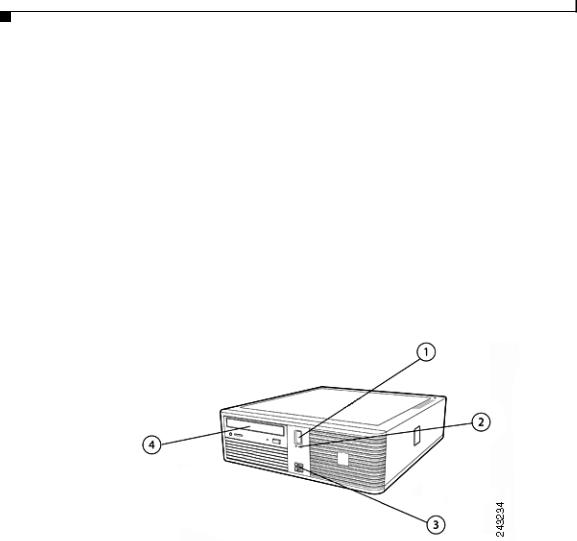
Chapter 1 Introducing the Cisco Wide Area Virtualization Engine
Hardware Features
Hardware Features
This section illustrates and describes the front and back panel controls, ports, and LED indicators on the WAVE-274 and WAVE-474. It contains the following topics:
•Front Panel Controls and LEDs, page 1-2
•Location of Ports and Connectors, page 1-3
Front Panel Controls and LEDs
Figure 1-1 shows the front panel controls and LEDs.
Figure 1-1 WAVE-274 and WAVE-474 Front Panel
1 |
|
Power button |
3 |
2 USB 2.0 ports (not supported) |
|||
|
|
|
|
|
|||
2 |
|
LEDs |
4 |
CD/DVD optical drive |
|||
|
|
|
|
|
|
|
|
|
|
|
|
Cisco Wide Area Virtualization Engine 274 and 474 Hardware Installation Guide |
|||
|
|
|
|
||||
|
1-2 |
|
|
|
OL-17739-01 |
|
|
|
|
|
|
|
|||

Chapter 1 Introducing the Cisco Wide Area Virtualization Engine
Hardware Features
The power control button powers up and powers down the system.
Note Any USB connector can be used to connect a keyboard, and the video connector can be used to connect a monitor. The keyboard and monitor are used only during the BIOS boot process for troubleshooting purposes. After the BIOS boots, all input and output for the appliance is by way of the serial console port.
Table 1-1 describes the front panel LEDs and their functions.
Table 1-1 |
Front Panel LEDs |
|
|
|
|
|
|
|
|
LED |
|
Color |
State |
Description |
|
|
|
|
|
Power-on |
|
Green |
On |
Appliance is powered on. |
|
|
|
Off |
AC power is not present. Power supply or |
|
|
|
|
LED has failed. |
|
|
|
|
|
|
|
Red |
Flashing |
There is a problem with the computer and it is |
|
|
|
|
displaying a diagnostic code. See the |
|
|
|
|
“Troubleshooting the System Hardware” |
|
|
|
|
section on page 5-1. |
|
|
|
|
|
Hard disk drive activity |
Green |
Flashing |
Hard disk drive is in use. |
|
|
|
|
|
|
DVD-ROM drive activity |
Green |
On |
CD/DVD drive is in use. |
|
|
|
|
|
|
Location of Ports and Connectors
The WAVE-274 and WAVE-474 appliances support one Ethernet port and one console port. This section contains the following topics:
•Ethernet Port Connector, page 1-5
•Console Port Serial Connector, page 1-6
Figure 1-2 shows the back panel ports and connectors.
|
|
Cisco Wide Area Virtualization Engine 274 and 474 Hardware Installation Guide |
|
|
|
|
|
||
|
OL-17739-01 |
|
|
1-3 |
|
|
|
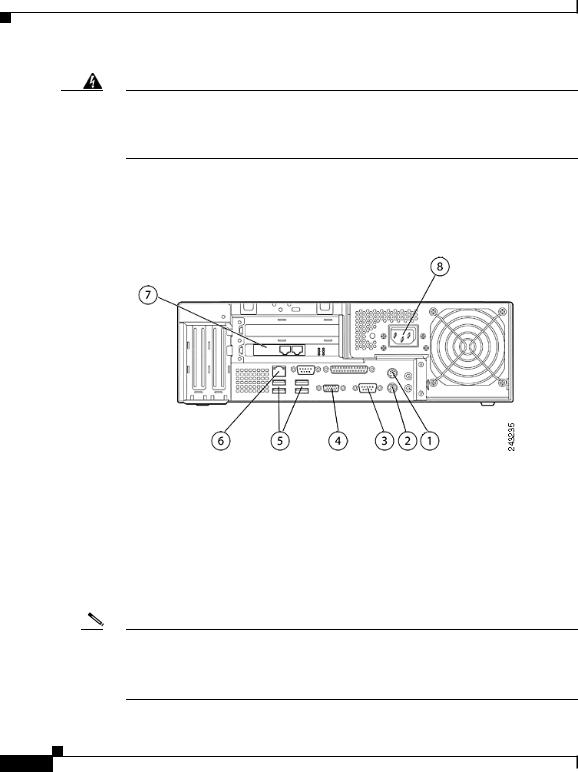
Chapter 1 Introducing the Cisco Wide Area Virtualization Engine
Hardware Features
Warning To avoid electric shock, do not connect safety extra-low voltage (SELV) circuits to telephone-network voltage (TNV) circuits. LAN ports contain SELV circuits, and WAN ports contain TNV circuits. Some LAN and WAN ports both use RJ-45 connectors. Use caution when connecting cables. Statement 1021
Figure 1-2 shows the location of the back panel connectors, and Table 1-2 describes the connector functions.
Figure 1-2 Back Panel LEDs and Connectors
1 |
PS/2 mouse port (unused) |
5 |
4 USB ports (unused) |
|
|
|
|
2 |
PS/2 keyboard port (unused) |
6 |
Ethernet port (RJ-45 LAN jack) |
|
|
|
|
3 |
Console port (RS232 serial COM1 port) |
7 |
Inline adapter (2 ports) |
|
|
|
|
4 |
VGA port (unused) |
8 |
AC power connector |
|
|
|
|
Note Any USB connector can be used to connect a keyboard, and the video connector can be used to connect a monitor. The keyboard and monitor are used only during the BIOS boot process for troubleshooting purposes. After the BIOS boots, all input and output for the appliance is by way of the serial console port.
|
Cisco Wide Area Virtualization Engine 274 and 474 Hardware Installation Guide |
1-4 |
OL-17739-01 |

Chapter 1 Introducing the Cisco Wide Area Virtualization Engine
Hardware Features
Table 1-2 |
Back Panel LEDs |
|
|
|
|
|
|
|
|
LED |
|
Color |
State |
Description |
|
|
|
|
|
Ethernet link |
|
Green |
On |
Active link connection on the 10BASE-T, |
|
|
|
|
100BASE-TX, or 1000BASE-TX interface for |
|
|
|
|
the Ethernet port. |
|
|
|
|
|
Ethernet activity |
|
Green |
On |
System is transmitting to or receiving signals |
|
|
|
|
from the Ethernet LAN that is connected to the |
|
|
|
|
Ethernet port. |
|
|
|
|
|
Ethernet Port Connector
Connect a Category 3, 4, or 5 unshielded twisted-pair cable to the Ethernet connector. 100BASE-TX and 1000BASE-T Fast Ethernet standards require Category 5 or higher cabling. The WAVE appliance has one Ethernet connector (see Figure 1-3).
The Ethernet controller is integrated on the system board. It provides an interface for connecting to a 10-Mbps, 100-Mbps, or 1-Gbps network and provides full-duplex (FDX) capability, which enables simultaneous transmission and reception of data on the network. If the Ethernet port in the server supports auto negotiation, the controllers detect the data-transfer rate (10BASE-T, 100BASE-TX, or 1000BASE-T) and duplex mode (full duplex or half duplex) of the network and automatically operate at that rate and mode. You do not have to set any jumpers or configure the controller.
Figure 1-3 Ethernet Port Connector
Activity LED |
|
|
|
|
|
|
|
|
|
|
|
Link LED |
|
|
|
|
|
|
|
|
|
|
|
||
|
|
|
|
|
|
|
|
|
|
|
||
(green) |
|
|
|
|
|
|
|
|
|
|
|
(green) |
|
|
|
|
|
|
|
|
|
|
|
|
83195 |
|
|
|
|
|
|
|
|
|
|
|
|
|
|
|
|
|
|
|
|
|
|
|
|
|
|
8 |
|
|
|
|
|
|
|
1 |
|
|
||
|
|
Cisco Wide Area Virtualization Engine 274 and 474 Hardware Installation Guide |
|
|
|
|
|
||
|
OL-17739-01 |
|
|
1-5 |
|
|
|

Chapter 1 Introducing the Cisco Wide Area Virtualization Engine
Hardware Features
Console Port Serial Connector
The WAVE-274 and WAVE-474 appliances have one console port (see Figure 1-4). Use the console port serial connector to connect to a console for accessing the WAAS command-line interface (CLI) or other serial device.
Figure 1-4 Console Port Serial Connector
1 |
5 |
83193
6 9
Note The WAVE appliance has two serial ports on the rear panel. Be sure to connect your console cable only to the port labeled COM1 or CONSOLE.
|
Cisco Wide Area Virtualization Engine 274 and 474 Hardware Installation Guide |
1-6 |
OL-17739-01 |

C H A P T E R 2
Preparing to Install the Wide Area
Virtualization Engine
This chapter contains important safety information that you should know before working with the WAVE appliance. Use the guidelines in this chapter to ensure your own personal safety and to help protect your appliance from potential damage.
This chapter contains the following sections:
•Safety Warnings, page 2-1
•Safety Guidelines, page 2-4
Note Read the Regulatory Compliance and Safety Information for the Cisco Content Networking Product Series document and the Site Preparation and Safety Guide that came with your appliance before you begin the installation.
Safety Warnings
Before you install the WAVE appliance, observe the following safety warnings.
Warning Only trained and qualified personnel should be allowed to install, replace, or service this equipment. Statement 1030
|
|
Cisco Wide Area Virtualization Engine 274 and 474 Hardware Installation Guide |
|
|
|
|
|
||
|
OL-17739-01 |
|
|
2-1 |
|
|
|
